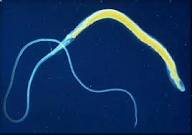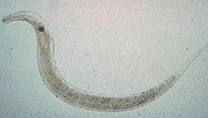Whipworms and Other Worm Parasites in Dogs
 An adult whipworm can be 2-3 inches long. It gets its names because threadlike for the most part but think at one end, looking like a whip. They live in the last part of the small intestine and the first part of the large intestine. Like tapeworms, they fasten to the wall of the gut. One thing that sets whipworms apart from most worm species in that the females lay fewer eggs than most and there are long periods of time when there are no eggs laid. This makes trying to find eggs in feces difficult, even when done repeatedly.
An adult whipworm can be 2-3 inches long. It gets its names because threadlike for the most part but think at one end, looking like a whip. They live in the last part of the small intestine and the first part of the large intestine. Like tapeworms, they fasten to the wall of the gut. One thing that sets whipworms apart from most worm species in that the females lay fewer eggs than most and there are long periods of time when there are no eggs laid. This makes trying to find eggs in feces difficult, even when done repeatedly.
When Fido has whipworms he could have acute, chronic or intermittent diarrhea. The stool may be mucoid (muscus like) and bloody and he will probably have trouble an strain when trying to defecate. If the infestation is heavy he will lose weight, develop anemia brood the blood loss and fail to thrive. You will be able to tell if your friend is having troubles using the restroom.
To prevent whipworms, the heartworm drug Interceptor is effective. Also, eggs remain infective for up to five years. This means that reinfestation is very common. Therefore keeping the yard clean and sanitary will definitely help your whipworm problem. When in public also be sure to obey all pooper-scooper rules. If you have a dog run that is made of dirt and your dog is infested with whipworms you may want to relocated the run or change it to gravel or paved with concrete. It is a pain to have to go through all of that work but having a healthy pup will be worth it!
In treating whipworms you can use one of the following: Drontal Plus, Panacur, Telmintic, and Vercom Paste. Take a visit to your vet to determine which treatment will be most effective on your dog because it is difficult to attain high drug concentrations in the colon, where whipworms live.
Let’s go over some other worm parasites and diseases you may come across when keeping Fido healthy
Threadworms or Strongyloides
 This type of roundworm in quite a bit smaller than most, it is just 2 mm long. They can live in the small intestines of both humans and dogs, they thrive is subtropical regions like the Gulf coast areas and the southeastern United States. Their lifecycle begins when the eggs and larvae are passed through feces. They infect by being digested or enter though penetrating the skin. They are mostly a problem in young puppies. If your puppy has profuse watery or bloody diarrhea, threadworms may be the problem. As the larvae move through the lungs they may also develop pneumonia. If our puppy has any of these signs take a visit to the vet, immediately. They only way to diagnose through stool examination is to use a microscope with fresh stool. Pretty gross, but you have to make sure you catch the stool right after its out of the pup. The most common treatment will be a 5-day course of Panacur, but Ivermectin is also effective even though it is not its labeled purpose. Your vet will help you with the treatment and process. If your dog or puppy has threadworms they need to be isolated until cured. This will be very difficult when you’re a new dog owner and your precious puppy is in the crate, but it is for your own good. Dogs can definitely infect humans and when a human is infected with threadworms it is a debilitating disease that leaves you with chronic diarrhea. Just follow the treatments from your vet so you and Rufus can get back to playing fetch!
This type of roundworm in quite a bit smaller than most, it is just 2 mm long. They can live in the small intestines of both humans and dogs, they thrive is subtropical regions like the Gulf coast areas and the southeastern United States. Their lifecycle begins when the eggs and larvae are passed through feces. They infect by being digested or enter though penetrating the skin. They are mostly a problem in young puppies. If your puppy has profuse watery or bloody diarrhea, threadworms may be the problem. As the larvae move through the lungs they may also develop pneumonia. If our puppy has any of these signs take a visit to the vet, immediately. They only way to diagnose through stool examination is to use a microscope with fresh stool. Pretty gross, but you have to make sure you catch the stool right after its out of the pup. The most common treatment will be a 5-day course of Panacur, but Ivermectin is also effective even though it is not its labeled purpose. Your vet will help you with the treatment and process. If your dog or puppy has threadworms they need to be isolated until cured. This will be very difficult when you’re a new dog owner and your precious puppy is in the crate, but it is for your own good. Dogs can definitely infect humans and when a human is infected with threadworms it is a debilitating disease that leaves you with chronic diarrhea. Just follow the treatments from your vet so you and Rufus can get back to playing fetch!
Pinworms
Humans can be infected by pinworms but contrary to popular belief they cannot be infected by dogs or cats. It is a concern in some families but your pets cannot acquire or spread these parasite.
Trichinosis
This disease comes from eating uncooked pork. Pork at this stage will contain the encysted Trichina spiralis larvae. The reported cases in humans each year always reveals a low number. But in dogs in is somewhat higher. Make sure you cook all meat for Fido and don’t allow him to go roaming in rural areas alone.
Lungworms
These parasites are about a centimeter long and very slender and hair like. There are multiple species that affect dogs. Capillaria aerophila is one. They can be acquired by ingesting their eggs in the soil or a host animal such as a snail, slug, or rodent. Lungworms live in the nasal cavity and upper air passages. Imagine worms living in your nose. EW. EW. EW. My nose started to itch just typing that sentence. They cause a mild cough, as would be expected. Another species, filaroides produce a bronchial and tracheal infection that is usually a kennel related problem.
Most lungworm infection in dogs are mild and the dog won’t show clinical signs.
If heavily infested and under two years old the dog may have weight loss, exercise intolerance and a persistent dry cough.
Diagnosis will be based on clinical signs, a chest x-ray or stool and/or respiratory secretion examinations for eggs. Treatment will include extended periods on time on the Panacur treatment. Always check in with the vet for advice.
Whipworms, or Any Worms, Round-up
Worms of any kind are no fun for the dog or the owner. They can be painful and hard to completely destroy. Be sure to use preventative actions to keep them away. Keeping the house and yard sanitary will be your best bet with prevention. If the occasion occurs where you find yourself in a bind with worms, help from your vet, an extra attention to detail, and a little patience you should be able to get your house, you, and your dog worm free in a matter of time.
Other Popular Health Articles
Common Health Problems
Credits Here

